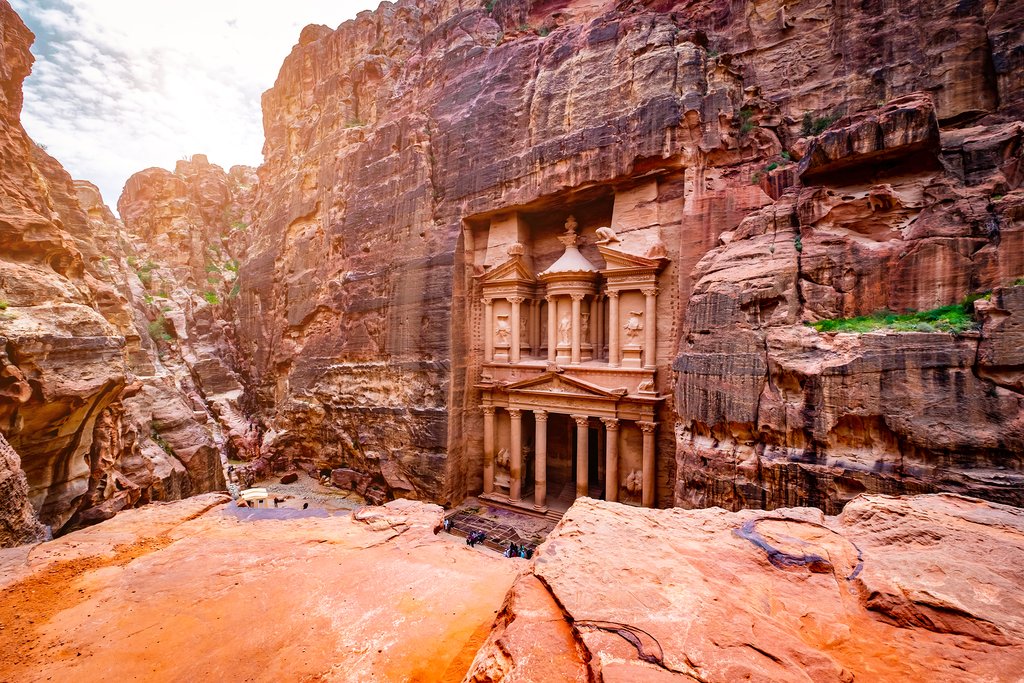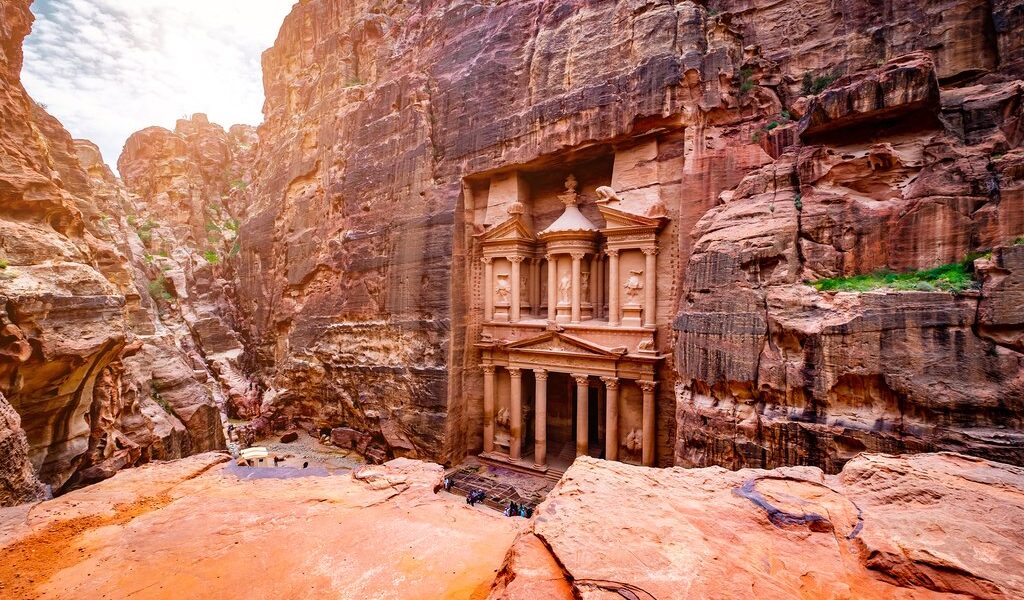
By April spring has arrived and with it, high season as visitors flock to experience Petra at the best time of year weather-wise. The Goldilocks temperatures are just right—neither too hot nor too cold. And the landscapes are briefly lush and ablaze with wildflowers. The down side is that Jordan’s most popular attraction is, well… Jordan’s most popular attraction!
## Experiencing Petra in April: A Comprehensive Guide
April is a truly special time to visit the magnificent city of Petra, a UNESCO World Heritage site and one of the New Seven Wonders of the World. This detailed guide offers insights into what you can expect during an April visit, covering weather conditions, crowd levels, costs, activities, and important cultural considerations.
**Weather in Petra**
The month of April signals the near-complete departure of the rainy season, ushering in the warmth and vibrancy of spring to Petra. The sun graces the ancient city with its presence, casting a golden glow upon the rose-red sandstone facades. Throughout the month, the average temperature hovers around a comfortable 64°F (18°C), making it ideal for exploring the vast archaeological site. As the days progress, temperatures tend to rise, culminating in a delightful average high of 75°F (24°C). This is perfect weather for extended exploration and outdoor activities.
However, it’s crucial to remember that Petra is a desert environment, and temperatures can fluctuate significantly, especially during the earlier part of April. The average low for the month is a brisk 50°F (10°C). Be prepared for some chilly mornings and evenings, as night temperatures in early April can occasionally dip close to the freezing point (0° Fahrenheit). Packing layers is essential to ensure your comfort throughout the day and night.
Rainfall becomes a less significant factor in April, with precipitation occurring on an average of only two days throughout the month. However, the preceding four-month “rainy” season leaves a lasting impact, transforming the desert landscape into a breathtaking spectacle. A kaleidoscope of wildflowers carpets the ground, offering unparalleled photographic opportunities for visitors to capture the beauty of the desert in bloom. The diverse array of colors and textures provides a stunning contrast against the dramatic backdrop of the ancient city.
While rain is infrequent in April, it’s crucial to be aware that when it does occur, it typically manifests as sudden and torrential downpours. These intense bursts of rainfall can pose a significant threat, particularly within the narrow defiles and broader canyons that characterize the landscape. The potential for flash floods is very real, and utmost caution is advised. Remember that these channels were carved over countless millennia by just such torrents of water! The iconic Siq, the narrow gorge that serves as the main entrance to Petra, can transform into a rushing riverbed during heavy rains, rendering the stones dangerously slippery. It’s important to be prepared for the possibility that the entire Petra site may be temporarily closed for safety reasons during periods of heavy rainfall. Always heed the advice of local authorities and guides regarding weather conditions and potential hazards.
In terms of attire, light summer clothing is definitely recommended for the warmer daytime temperatures. Don’t forget to pack essentials like a wide-brimmed shade hat and high-SPF sunscreen to protect yourself from the strong desert sun. However, be sure to bring a warm jacket or sweater for the cooler evenings and the possibility of encountering a rare cold snap. And of course, sturdy and comfortable walking shoes are an absolute must, as you’ll be doing a significant amount of walking and climbing as you explore the vast expanse of Petra.
**Crowds and Costs in Petra**
April stands out as the most popular month to visit Petra, attracting visitors from all corners of the globe. As a result, you can expect higher crowd levels, especially at iconic locations like the Treasury, also known as Al-Khazneh, and other easily accessible sites. During peak hours, navigating through tour groups can be challenging, making it feel like elbow-room only at the most popular locations.
To make the most of your visit during this busy period, it’s highly recommended to begin your exploration as early as possible, ideally when the Petra site first opens its gates. This will allow you to experience the beauty and majesty of the ancient city with fewer crowds. Consider venturing off the beaten path and exploring the more remote sites that are further away from the main tour group routes. These hidden gems often offer a more tranquil and intimate experience, allowing you to fully appreciate the beauty and history of Petra.
Due to the high demand, hotels and tourist packages tend to be at their most expensive during April. Bargains are as rare as rain in the desert during this peak season. Therefore, it’s essential to plan ahead and book your flights and accommodations well in advance to secure the best prices and availability.
It’s also important to be aware of the Islamic holy month of Ramadan, which can affect the operating hours of some businesses. In 2020, Ramadan falls in April. During this time, many businesses may adjust their hours of operation. For example, many restaurants and shops may close between 6:30 pm and 8:30 pm to allow owners and workers to break their fast and enjoy their evening meal. The ticket office at Petra usually closes one hour earlier than usual during Ramadan. However, aside from these adjustments, it’s generally business as usual at Petra during Ramadan.
**Things to Do in Petra**
The Petra Archaeological Park (PAP) encompasses a vast area of approximately 100 square miles (264 square kilometers), offering a wealth of attractions that extend far beyond the well-known ancient ruins. While visiting the Treasury, the Colonnaded Street, and the Great Temple are essential experiences, be sure to allocate time to explore the High Places, which offer sensational panoramic vistas of the entire site. Climbing to these elevated locations provides a unique perspective, allowing you to fully appreciate the scale and majesty of Petra.
One of the most popular hikes is the steep trail (allow approximately 40 minutes) that leads to the High Place of Sacrifice, located atop Jebel Madbah. In addition to the breathtaking views, you can also admire the Obelisks, which are giant totems carved directly into the rock face. From the High Place of Sacrifice, you can descend to Wadi Farasa and the Roman Soldier’s Tomb, a two-hour hike that offers breathtaking views and a chance to immerse yourself in the natural beauty of the surrounding landscape. The month of April is particularly rewarding for this hike, as the desert will be ablaze with wildflowers, adding an extra layer of beauty to the experience.
By late May, the prospect of a full day of hiking can become somewhat daunting due to the increasing heat. You may encounter touts offering camel or donkey rides as an alternative mode of transportation. Keep in mind that your entrance ticket includes a horseback ride from the visitor’s center to the entrance of the Siq. Consider saving this option for your return journey, as the route back to the visitor center is often uphill.
In addition to the main Petra site, there are plenty of other points of interest located not too far away. If you have an interest in history, consider visiting Shobak Castle (it’s best visited before Petra, located approximately 25 miles/42 kilometers to the south). Perched dramatically atop a hill, this imposing Crusader castle was originally built in 1115 and withstood an 18-month siege in 1189 before eventually succumbing to Saladin’s army. In the 14th Century, it was taken over and rebuilt by the Mamluks. Today, staff dressed in traditional Mamluk costumes greet visitors, adding to the historical atmosphere. For those who don’t suffer from claustrophobia, a highlight is the once-secret passageway where 375 steps descend to a subterranean spring.
**April Events in Petra**
The most significant event in April is undoubtedly Ramadan. The dates shift backward by approximately 11 days each year according to the lunar calendar. The entire Muslim community engages in prayer, fasts from sunrise to sunset, practices charity and self-evaluation, and strives to resist all temptations.
The end of Ramadan and the fasting period is marked by Uraza Bayram (Eid Al Fitr), a joyous celebration that lasts for several days. During this time, people come together to celebrate with festivities and expressions of gratitude. Most businesses in Petra remain open during Uraza Bayram, especially because it is high season for tourism. However, it’s wise to expect some restaurants to close at sundown so that owners and workers can eat.
B-1470

